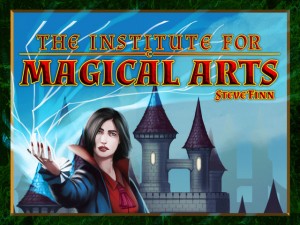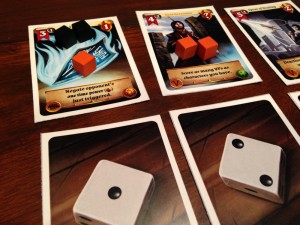Note: This preview uses pre-release components and rules. What you see here may be different from the final, published game.
 The Archmage is dead. The time has come to decide who will take his place at the head of the Institute? You are a candidate…but so is your opponent! That’s the theme of the newest game by Dr. Finns Games (Gunrunners, Capo Dei Capi), The Institute for Magical Arts. You and another player are competing for the loyalty of fellow wizards, magical artifacts and spells. Is this two player game another success by Dr. Finn? Let’s find out!
The Archmage is dead. The time has come to decide who will take his place at the head of the Institute? You are a candidate…but so is your opponent! That’s the theme of the newest game by Dr. Finns Games (Gunrunners, Capo Dei Capi), The Institute for Magical Arts. You and another player are competing for the loyalty of fellow wizards, magical artifacts and spells. Is this two player game another success by Dr. Finn? Let’s find out!
The Institute for Magical Arts is a two player, dice rolling and area control game that plays in about 30 minutes.
Game Overview:
In the Institute for Magical Arts, players are competing for a variety of cards in the center of the table. Each of these cards will provide players with victory points and sometimes special abilities. During the game, players will be rolling dice, assigning influence (by placing power stones) and trying to assert their control over the aforementioned cards. Win a card and you gain valuable victory points and sometimes special powers. Be the first to 20 victory points and you win!
How To Play:

Like all of Dr. Finn’s games, the rules in The Institute for Magical Arts are easy to pick up and fairly intuitive. Each player chooses a color and collects their dice, cards and powers stones. In the center of the table are 6 cards numbered 1-6 (representing the 6 faces on a die). Players draw an institute card and place it next to each of those 6 cards. The 6th card is actually the portal card, which always starts the game in that position. Finally the Ethereal Realm card is placed to the side of the portal card. Once the game is setup, really a quick process, players are ready to begin.
The game is played over a series of rounds, each of which has 5 phases:
1. Assign dice to action cards – Players roll their 4 dice and then assign one card to each die, face down. The cards will let players either collect power stones or assign them to the center cards.
2. Take and cast power stones – For each card they play that says “take power stones”, the player takes a number of stones equal to the pips on the die next to it. For each “place a power stone” card, players assign a power stone to the institute card next to the matching numbered card in the center of the table. This is how they begin to claim cards via the area majority mechanic.
3. Use the portal – This is probably the most confusing card of the game (and it really isn’t that hard to understand). The Portal card lets players shift stones from the portal to other numbered cards or the Ethereal Realm card. This allows players to be flexible during the game and move stones around.
4. Trigger phase 4 powers – Once players starting winning item cards, they can take advantage of the special abilities that they grant. Many of them are played during the other phases, but some are specifically played during this phase.
5. Award institute cards – Finally, players check to see if they’ve won any cards. Each card has 2 numbers on it, a number to represent the amount of stones a player must have placed to claim the card, and a second number that represents how much they have to beat the other player by. So, for example with a 4/2 card, while a player may have placed the 4 required stones to win the card, if they haven’t placed at least 2 more stones then the other player, they can’t claim it. Any won cards are replaced from the draw deck after sliding all other cards to the left. After that the round ends and another one begins.
Rounds will continue in this manner until one player has claimed enough institute cards to reach the 20vp threshold and win.

Game Experience:
I actually played through a few iterations of this game as Dr. Finn was constantly refining the rules during his play-testing stage. I must say, I’m glad he kept working on them because the early versions weren’t my favorite. That being said, the final version of Institute for Magical Arts was really fun. Dr. Finn did a great job of creating an interactive area control game.
I think this is probably one of Dr. Finns most complex games to date (I’ve tried all his games expect Biblios), only because I feel like there are a lot of moving parts to it. Players will be constantly shifting around stones, cards and using special abilities. This is great in my opinion, as the game contains enough depth for us to stay entertained over multiple plays. I had a lot of fun with The Institute for Magical Arts and even though it’s a filler game, I’d put it at the higher end of that spectrum.

Looking deeper, The Institute for Magical Arts seems to have a good mix of luck and strategy that I think will appeal to many gamers. Lady luck plays her hand in both the dice rolling and by which cards appear in the center battle line. However Dr. Finn has given players a variety of ways to mitigate the randomness of luck, which I appreciate.
When it comes to dice rolling, players have 6 different cards to choose from (and even a couple of reroll tokens) so they should be able to get the right mix and match each turn. Even if you don’t roll the right number you need to finally capture that card, the inclusion of the portal card might let you shift things around as necessary. This was a great move by Dr. Finn. While you will still be tied to the luck of the dice, they shouldn’t be able to cripple you with some unlucky rolls.
The Institute for Magical Arts also has a healthy dose of player interaction. The early version we play tested actually didn’t have a lot of this, so I’m glad he reworked his design into the current version. Using both the Portal Card and special abilities from items you’ve claimed, players will have a variety of ways to mess with their opponents. Of course, you’ll also be fighting for those cards in the middle, so be prepared for plenty of back and forth lead changes. The Ethereal Realm card is sure to be one of the most hotly contested cards in the game as it can award victory points to a player every round! You can’t let your opponent is on that card if you hope to win.

Finally, while we aren’t supposed to comment on the artwork in Kickstarter previews, I love the art direction in the prototype we were given. The artwork colorful, well done and really fits the theme of the game. I’m not sure the artist Dr. Finn chose, but it was a great choice in my opinion. I can’t wait to see the finished product!
Final Thoughts:
Dr. Finn has another winner on his hands in The Institute for Magical Arts. This small publisher is quickly becoming one of my favorite producers of filler games. The Institute for Magical Arts somewhat reminds me of a previous title of his, Capo dei Capi, and I think he probably built off the lessons he learned in that game. Either way, I look forward to getting my hands on the retail copy of this game and I think it will sit happily on my shelf next to Capo di Capi.
The Institute for Magical Arts is currently in funding in Kickstarter. If you’d like to become a backer, a $25 pledge will get you a copy of the game and any applicable stretch rewards. There are also other backer levels if you’d like to get some of Dr. Finns other titles included with your pledge. The Institute for Magical Arts is scheduled to be in backer’s hands in February of 2015 and you have until Monday, September 1st to become a backer. So head over today and check it out.
As always, we don’t post ratings for preview copies as the components and rules may change from the final game. Check back with us after the game is produced for a full review




















